Saint Peter’s Basilica, the world’s largest church, is the center of Christianity. The imposing structure was built over a span of more than one hundred years by the greatest Italian architects of the era.

The church is built on Vatican Hill, across the Tiber river from the historic center of Rome. The location is highly symbolic: this was the site where Saint Peter, the chief apostle, died a martyr and where he was buried in 64 AD. St. Peter is considered the first pope, so it made perfect sense for the papacy to build the principal shrine of the Catholic church here.
Brief History
The First Basilica
In the early fourth century Emperor Constantine, the first Christian emperor of Rome, decided to build a basilica on Vatican Hill at the site of small shrine that marked the likely location of the tomb of St. Peter. Construction of the basilica started between 319 and 322. It was consecrated in 326 AD and finally completed around 349 AD. To facilitate the construction, a part of the terrain was leveled and the necropolis where St. Peter was originally buried was demolished.
The basilica had an eighty-five-meter-long (279 ft.) nave with four aisles and a spacious atrium with a central cantharus (fountain), enclosed by a colonnade. A bell tower stood at the front of the atrium. Visitors entered the atrium through a triple-arched portico.
The New St. Peter’s Basilica
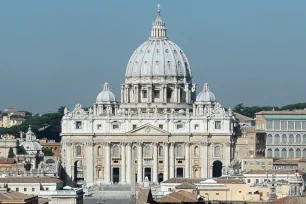
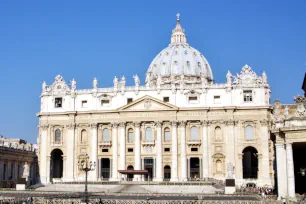
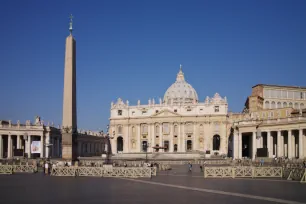
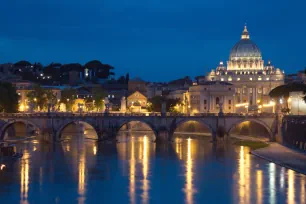
In the middle of the fifteenth century, the basilica was falling into ruin and Pope Nicolas V ordered the restoration and enlargement of the church after plans by Bernardo Rossellino. After Nicolas V died, works were halted.
No progress was made for half a century until Pope Julius II decided to build a completely new church. He appointed Donato Bramante as chief architect. Bramante designed a structure with a high dome on a Greek cross plan (all sides have equal lengths). In 1506 Julius II laid the first stone of the new basilica which was to become the largest in the world.
After Bramante’s death in 1514 he was succeeded by a number of different architects, all of whom made changes to the design, most notably Michelangelo Buonarroti, who became chief architect in 1547 at the age of seventy-two. He conceived the imposing dome and made further alterations to the plans.
At the time of Michelangelo’s death in 1564 only the drum of the dome was built. The dome was finally completed in 1590 by Giacomo della Porta. On request of Pope Paul V the imposing edifice was extended further into a true Latin cross plan by Carlo Maderno, who completed the main facade in 1614. The church was finally reconsecrated in 1626 by Pope Urban VIII, exactly 1,300 years after the consecration of the first church. Ever since, the St. Peter’s Basilica has been the center of Christianity, drawing pilgrims and tourists from all over the world.

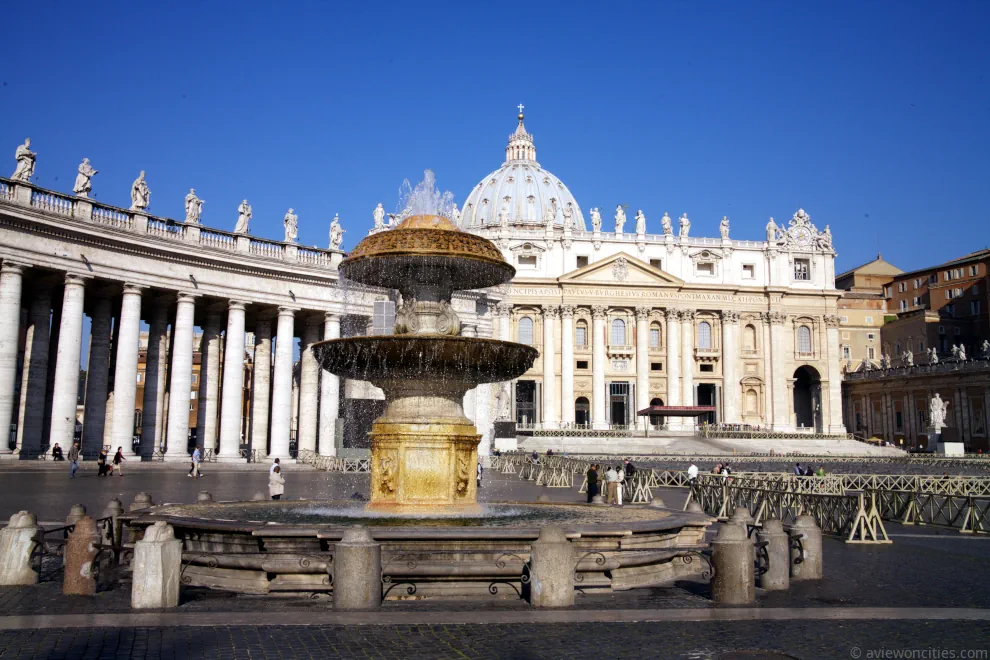
St. Peter’s Square
Visitors on their way to the St. Peter’s Basilica pass along St. Peter’s Square, a grandiose elliptical esplanade created in the mid seventeenth century by Gian Lorenzo Bernini. The square is bordered by massive colonnades that symbolize outstretched arms. Bernini and his assistants sculpted the 140 statues of saints that grace the balustrades on the colonnades.
The square is decorated with fountains and an Egyptian obelisk that was transported to Rome in 37 AD. The view of St. Peter’s Basilica from the square is unfortunately a bit disappointing; the result of the enlargement of the church carried out by Carlo Maderno, which partly obscures Michelangelo’s dome.
The Building
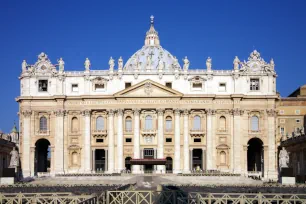
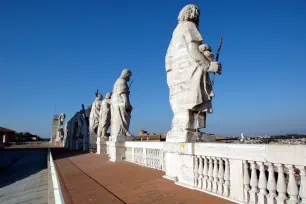
The building itself is truly impressive. The largest church in the world, it has a 211.5 meter long nave (694 feet, including the narthex). The basilica’s dome is one of the world’s largest measuring 42 meters in diameter and reaching 132.5 meters high (more than 434 feet).
Front Facade
The travertine front facade of the basilica was created by Carlo Maderno, who slightly altered Michelangelo’s original design by widening the narthex to 114.7 meters. Maderno also placed the massive columns against the walls instead of in front of the building, as Michelangelo had intended.
The 45.5-meter-high (149 ft.) facade is crowned with 5.7-meter-tall statues of Christ, John the Baptist and the apostles except for St. Peter. On either side are huge clocks supported by angels and decorated with ornaments and the papal crest. They were added in the early nineteenth century and are the work of Giuseppe Valadier. Below the clock on the left you can see the church bells.
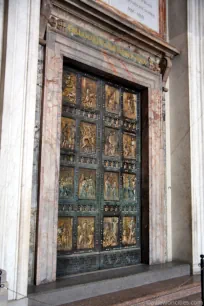
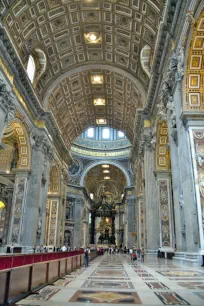
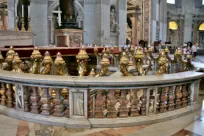
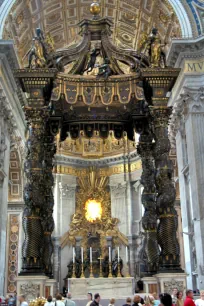
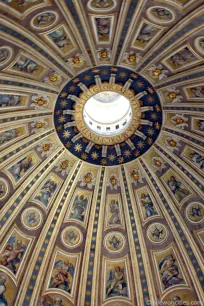
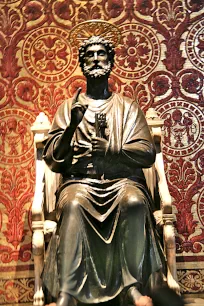
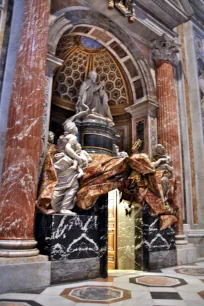
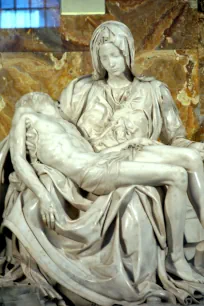
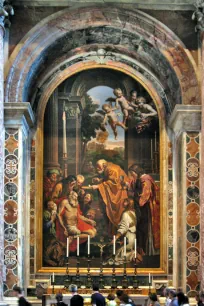
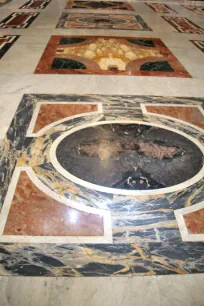
Narthex
Five entrances lead to the narthex (the lobby area) of the church, where you find an equestrian statue of Charles the Great on the left and another equestrian statue of Emperor Constantine, created by Bernini. Five doors lead from the narthex to the nave of the basilica. The central bronze door was created in the fifteenth century by the Florentine sculptor and architect Filarete for the old basilica. The door on the right is the Porta Santa, the holy door which is only opened once every twenty-five years.
Interior
Once inside the nave the enormous size of the church becomes apparent. The basilica has a surface area of 15,160 square meters, enough space to accommodate 60,000 visitors. It is covered by a coffered barrel vault ceiling and a huge central dome.
The opulence of the interior bears testimony to the wealth of the Catholic church in the sixteenth and seventeenth centuries. It is decorated with large monuments, many of which were created by Gian Lorenzo Bernini, one of the greatest artists of all time.
One of his main creations invariably draws the immediate attention of visitors: the enormous, twenty-six-meter-tall bronze baldachin over the papal altar. The Baroque masterpiece is crafted from bronze that was taken from the ceiling and pediment of the Pantheon. The design of the spiraling columns was inspired by marble columns that originally adorned the crypt of the old basilica.
In front of the papal altar is the confessio (burial crypt) that marks the presumed grave of St. Peter. It is encircled by a balustrade with ninety-five bronze oil lamps.
The confessio is located right below the majestic dome. Look up and you’ll see the impressive colorful vaulting with sixteen ribs that are supported by four massive pillars. The triangular spaces where the pillars meet the dome are decorated with mosaics depicting the evangelists. Light enters through the lantern and the sixteen large windows below the cornice.
Huge niches in the pillars hold five meter tall statues of the saints Andrew, Veronica, Helena and Longinus. The latter was created by Bernini, the others by students and assistants of the master. They stand on pedestals that are almost as tall as the statues that are placed on them. Above the niches are loggias that hold the relics associated with the four saints.
The pillar with the statue of Longinus also provides the backdrop for a bronze statue of St. Peter. First thought to be a late-classical work, it is now attributed to Arnolfo di Cambio, a thirteenth century architect and sculptor.
The apse of the basilica is decorated with a bombastic Baroque work that integrates the Cathedra Petri, the supposed chair of St. Peter. The chair is encapsulated in a bronze throne with reliefs that is supported by four church fathers; Athanasius and Johannes represent the Eastern Church while Ambrose and Augustine represent the Western Church. Above the throne is a large oval window surrounded by numerous angels.
The tomb of Pope Urban VIII (†1644), to the right of the throne, was also created by Bernini. The tomb opposite, of Paul III (†1549), is the work of Giacomo della Porta. There are plenty more tombs and sepulchral monuments in St. Peter’s, most notably the monument to Alexander VII (†1667), another work of Bernini. It depicts the pope praying in front of a skeleton holding an hourglass. Statues alongside the skeleton represent virtues. One of the figures was originally nude but the prudish Pope Innocent XI ordered Bernini to cover it with a marble drape. Another notable monument is the tomb of Innocent VII (†1406), sculpted in 1498 by Antonio del Pollaiolo. It is the only papal tomb in the church that was transferred from the original fourth century basilica.
The most famous monument in the St. Peter’s Basilica is the Pietà, a marble sculpture of a young looking Mary holding the dead body of her son. It was created in 1499-1500 by Michelangelo at the early age of twenty-five. The monument is located in the first chapel on the right. It is the only work of Michelangelo that bears his signature. He etched his name on the ribbon that runs across Mary’s chest, allegedly after he heard that people attributed his work to another artist. The sculpture was heavily damaged in 1972 when a deranged visitor hit it with a hammer; it is now protected by a bulletproof glass screen.
Most of the paintings in the church are replicas of the original paintings created for the basilica, many of which are now on display in the Vatican Pinacoteca. The high humidity in the church ruined the oil paintings which started to suffer from mold damage. Some have been replaced by mosaics such as ‘The Transfiguration’, a painting by Raphael, which was recreated in 1774 as a mosaic by Stefano Pozzi.
The floor of the basilica has a colorful marble pattern. Look for the red porphyry disc near the central door. In the old church it was located in front of the main altar. Emperors – most notably Charles the Great (in 800 AD) – were crowned while standing on the disc. There are also bronze markings that compare the size of the church with that of others, including the St. Paul’s Cathedral in London and the Cologne Cathedral.
Right in front of the left transept is the entrance to the Museo Storico-Artistico (entrance not free), better known as the tesoro or treasury. On display are several historic crucifixes, including the sixth-century Crux Vaticana. There are also objects taken from the old church, such as a tabernacle created by Donatello.
It is also possible to visit the Sacre Grotte or Grotte Vaticane, a necropolis below the nave where you find the graves of more than one hundred popes. The Grotte was created when the floor of the new basilica was built 3.2 meters above the old one. It can be reached via a stair near the statue of Longinus.
The Dome and Viewing Platform
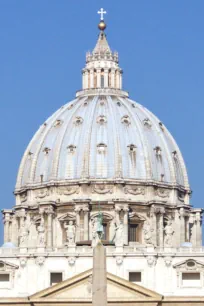
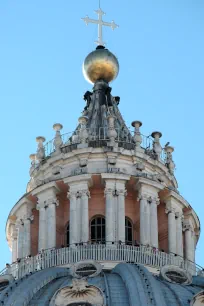
The crowning piece of the St. Peter’s Basilica is the majestic dome, a masterpiece designed by Michelangelo. The dome has a diameter of 42.34 meters and rests on four massive five-sided pillars. On top of the pillars rests a cylindrical drum – with sixteen large rectangular windows – that supports the ribbed vault. The ribs come together at the oculus on which an enormous lantern is placed. The outside of the drum and lantern are decorated with double Corinthian pillars.
There is a viewing platform at the base of the lantern from where you can enjoy an unparalleled panorama over Rome. You have the option of taking the elevator or the stairs, the latter being a bit cheaper. At the foot of the dome you can walk onto the roof terrace, from where you get a close-up view of the dome. The galleries inside give you a birds-eye view of the interior of the church. From here a long, narrow and spiraling staircase brings you to the top of the dome. The staircase is situated between the inner and outer shells of the dome, so the walls are somewhat slanted. The rather uneasy climb and the entrance fee are definitely worth it though since you are rewarded with one of the best views over the city and over St. Peter’s Square in particular.
Location
St. Peter’s is located in Vatican City, across the river Tiber, west of Rome’s center. Vatican City is completely surrounded by the city of Rome. The nearest subway station is Ottaviano, from where the Via Otaviano leads straight to St. Peter’s Square. Entrance to the basilica is free but make sure you are dressed properly since a very strict dress code is enforced.
- Next: Pantheon
- More Sights & Attractions in Rome
- Related articles:

